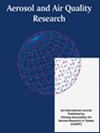污染方法对N95口罩消毒的影响:滴剂与气溶胶
IF 2.5
4区 环境科学与生态学
Q3 ENVIRONMENTAL SCIENCES
引用次数: 0
摘要
最近在SARS-CoV-2大流行期间,过滤式面罩呼吸器(ffr)的使用激增,引发了对其安全再利用和/或处置的经济和环境担忧。通过紫外线(UV)照射对其进行净化,在台架试验中证明是有效的。然而,目前还没有研究调查污染方法在多大程度上影响了去污方法的性能。在本研究中,枯草芽孢杆菌孢子接种于三种悬浮液中,通过气溶胶雾化或2µL滴滴沉积的方式污染ffr。然后在单色UVC灯准直光束反应器中暴露于紫外线照射下。结果表明,液滴(在150 mJ cm -2下最大0.72对数损失和3对数失活)比气溶胶(在150 mJ cm -2下最大2.47对数损失和1.75对数失活)的污染和去污效率更高。根据动力学模型,用人工唾液污染的孢子失活程度更高,其次是磷酸盐缓冲液,最后是用粘蛋白污染的人工唾液,后者也呈现出最高的抗性孢子比例。消毒对污染方法敏感(p < 0.001)。然而,污染悬浮液的组成是紫外线照射去污最重要的性能预测因子(p = 9.2 × 10 -10)。本文章由计算机程序翻译,如有差异,请以英文原文为准。
Impact of the Contamination Method on the Disinfection of N95 Respirators: Drops versus Aerosols
The recent surge in the use of filtering facepiece respirators (FFRs) during the SARS-CoV-2 pandemic triggered economic and environmental concerns with regards to their safe reuse and/or disposal. Their decontamination through ultraviolet (UV) irradiation has proven efficient in bench tests. Nevertheless, no study has yet investigated to what extent the decontamination method’s performance was impacted by the contamination method. In this study, Bacillus subtilis spores were inoculated in three suspensions used to contaminate coupons of FFRs via aerosols nebulisation or 2 µ L drops deposition. The contaminated coupons were then exposed to UV irradiation in a monochromatic UVC lamp collimated beam reactor. The results revealed that contamination and decontamination were more efficient for drops (maximum 0.72 log losses and 3 log inactivation at 150 mJ cm –2 ) than for aerosols (maximum 2.47 log losses and 1.75 log inactivation at 150 mJ cm –2 ). Inactivation was greater in coupons contaminated using artificial saliva, followed by phosphate buffer solution, and finally artificial saliva with mucin which also presented the highest fraction of resistant spores, based on kinetic modeling. Disinfection was determined sensitive to the method of contamination ( p < 0.001). However, the composition of the contaminating suspension was the most important performance predictor for decontamination by UV irradiation ( p = 9.2 × 10 –10 ).
求助全文
通过发布文献求助,成功后即可免费获取论文全文。
去求助
来源期刊

Aerosol and Air Quality Research
ENVIRONMENTAL SCIENCES-
CiteScore
8.30
自引率
10.00%
发文量
163
审稿时长
3 months
期刊介绍:
The international journal of Aerosol and Air Quality Research (AAQR) covers all aspects of aerosol science and technology, atmospheric science and air quality related issues. It encompasses a multi-disciplinary field, including:
- Aerosol, air quality, atmospheric chemistry and global change;
- Air toxics (hazardous air pollutants (HAPs), persistent organic pollutants (POPs)) - Sources, control, transport and fate, human exposure;
- Nanoparticle and nanotechnology;
- Sources, combustion, thermal decomposition, emission, properties, behavior, formation, transport, deposition, measurement and analysis;
- Effects on the environments;
- Air quality and human health;
- Bioaerosols;
- Indoor air quality;
- Energy and air pollution;
- Pollution control technologies;
- Invention and improvement of sampling instruments and technologies;
- Optical/radiative properties and remote sensing;
- Carbon dioxide emission, capture, storage and utilization; novel methods for the reduction of carbon dioxide emission;
- Other topics related to aerosol and air quality.
 求助内容:
求助内容: 应助结果提醒方式:
应助结果提醒方式:


